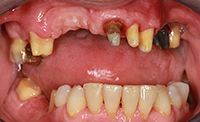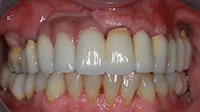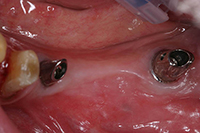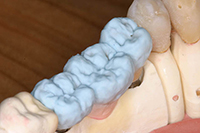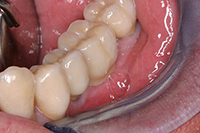Bridges are mainly used to replace one or more teeth missing between teeth that are still present. A bridge always goes from one bank to another, in dental terms from one tooth to another.
We make bridges if the missing teeth cannot be replaced by implants for any reason and if crowns have been or are to be fitted to the neighbouring teeth. If the neighbouring teeth are undamaged, we recommend that missing teeth be replaced by implants.
Once the teeth affected have been ground, an impression of the jaw is taken to create a hollow mould with a perfect negative of the tooth surfaces. The dental technician fills this with liquid plaster, which hardens to form a plaster cast of the patient's mouth. Individual teeth or stumps can be taken out of the model for precise processing.
Bridges also need a metal substructure, made either of a high-quality precious metal alloy or created by CAD/CAM using zirconium oxide. Small bridges can now also be manufactured using IPS e.max™. The substructure is first fitted in the patient's mouth, checked to make sure that it fits perfectly with no pulling, and modified if necessary. Afterwards, the substructure is blended with ceramic material in such a way that the finished bridge matches the real teeth perfectly in terms of shape, colour and function (see also "Ceramics in dentistry"). As with crowns, bridges are affixed using modern cements.
We make bridges if the missing teeth cannot be replaced by implants for any reason and if crowns have been or are to be fitted to the neighbouring teeth. If the neighbouring teeth are undamaged, we recommend that missing teeth be replaced by implants.
Once the teeth affected have been ground, an impression of the jaw is taken to create a hollow mould with a perfect negative of the tooth surfaces. The dental technician fills this with liquid plaster, which hardens to form a plaster cast of the patient's mouth. Individual teeth or stumps can be taken out of the model for precise processing.
Bridges also need a metal substructure, made either of a high-quality precious metal alloy or created by CAD/CAM using zirconium oxide. Small bridges can now also be manufactured using IPS e.max™. The substructure is first fitted in the patient's mouth, checked to make sure that it fits perfectly with no pulling, and modified if necessary. Afterwards, the substructure is blended with ceramic material in such a way that the finished bridge matches the real teeth perfectly in terms of shape, colour and function (see also "Ceramics in dentistry"). As with crowns, bridges are affixed using modern cements.

On implants
It is not absolutely necessary to insert implants if several teeth are missing. If an entire jaw normally containing 14 teeth is to be rehabilitated, for example, only six to eight implants are necessary because the spaces in between can be filled by bridges.
The dental technician starts by making implant abutments (see also "Crowns on implants") before adding a substructure made of precious metal or created using CAD/CAM and zirconium oxide.
Once this had been fitted in the patient's mouth, it is blended with ceramics then screwed or cemented in.


